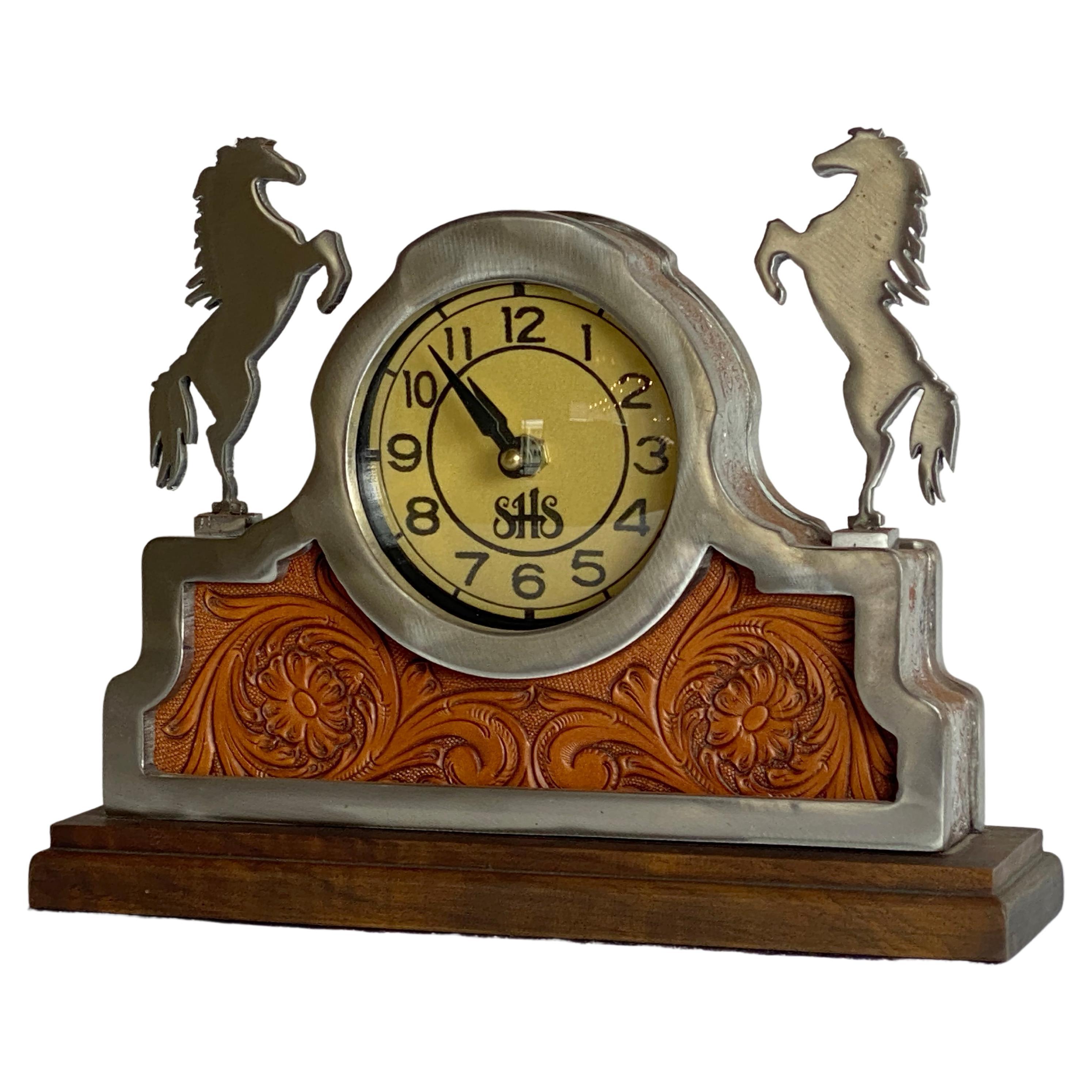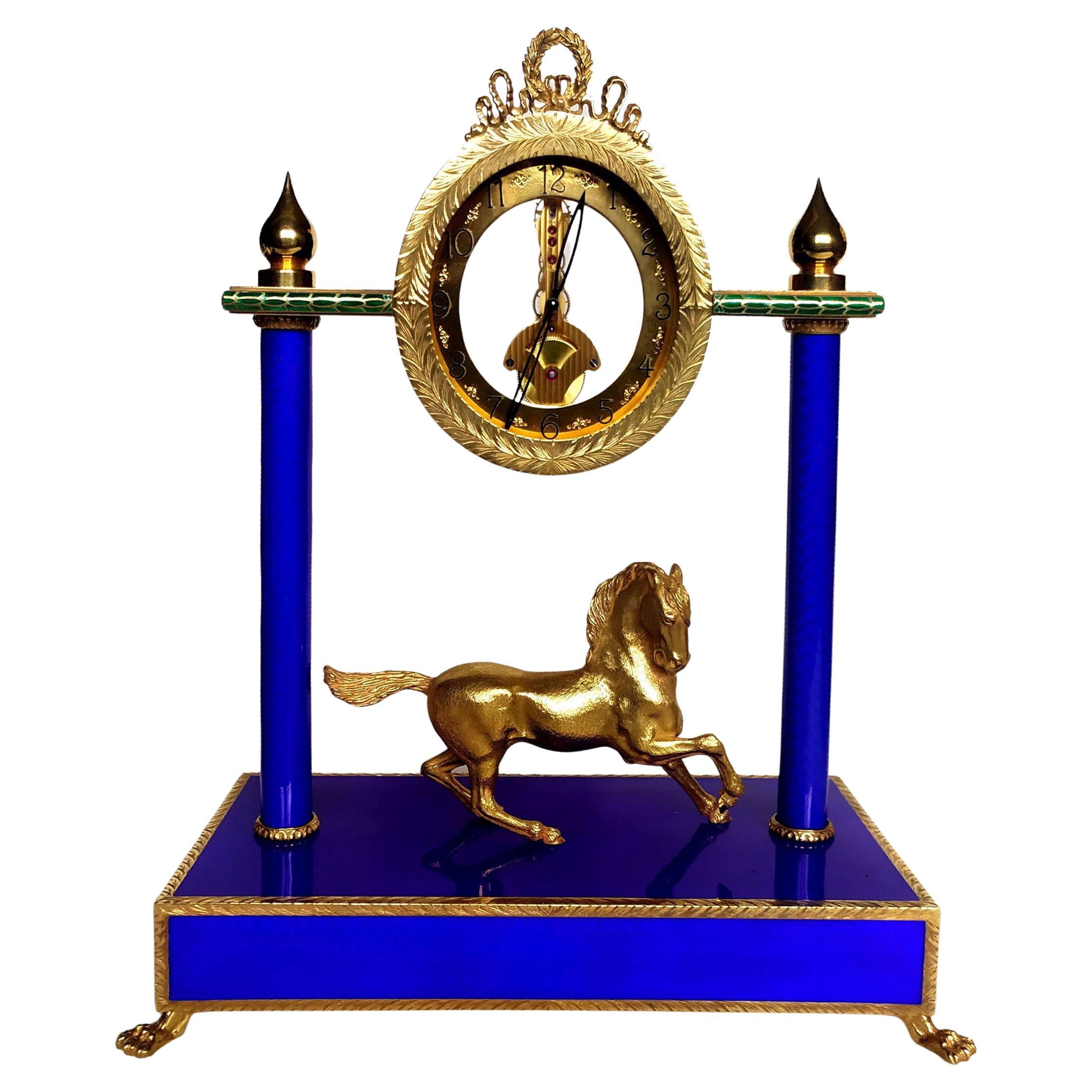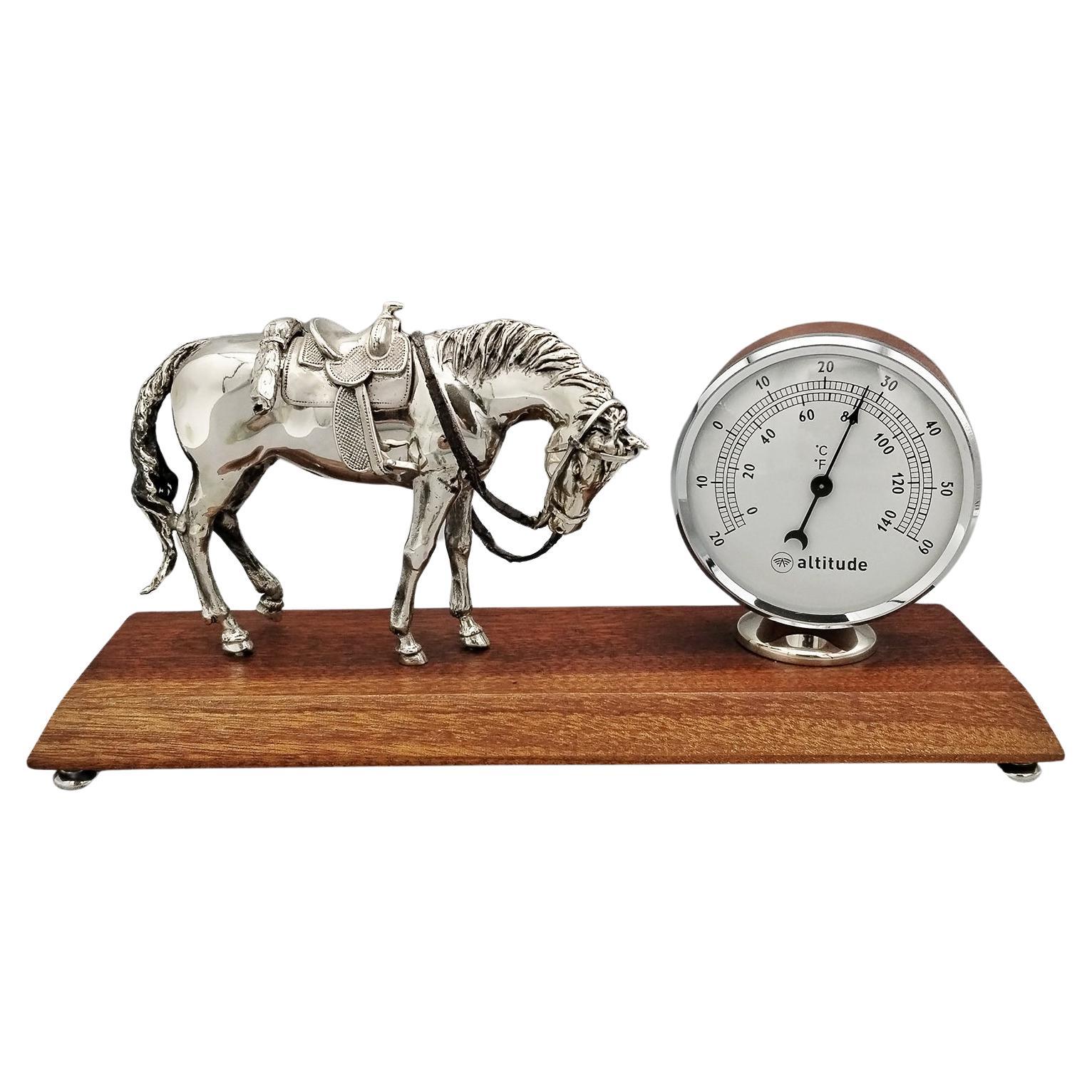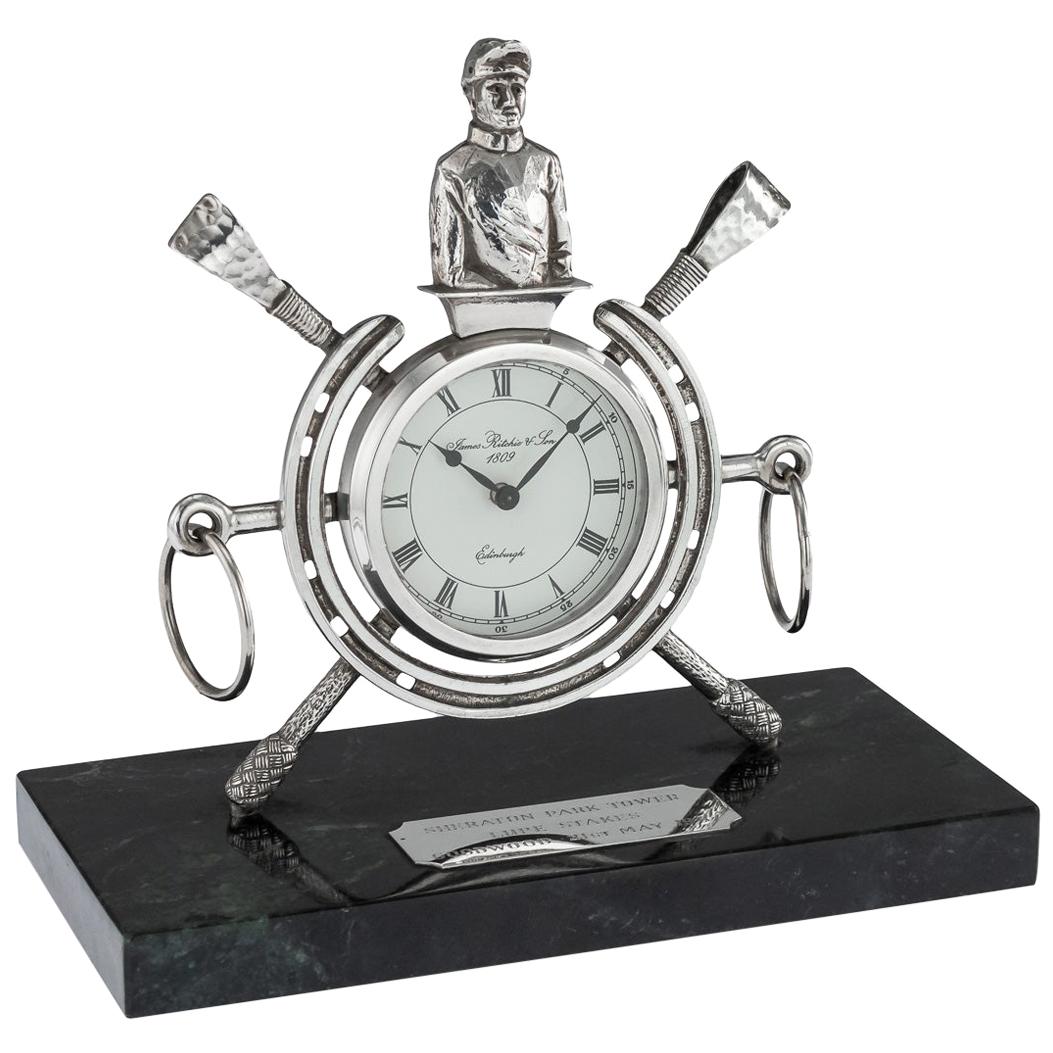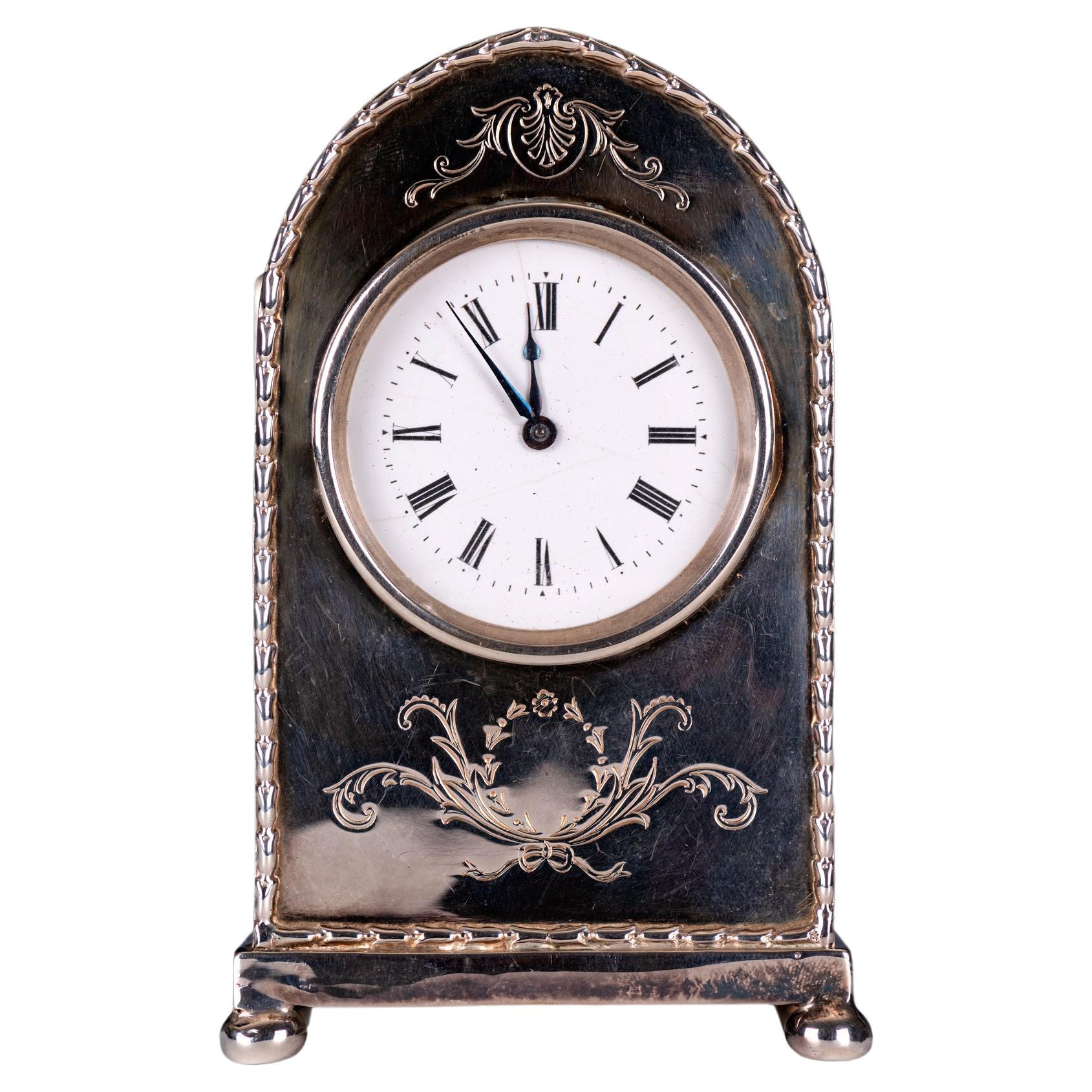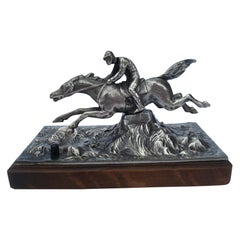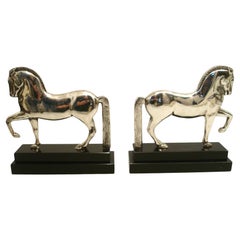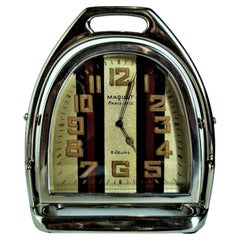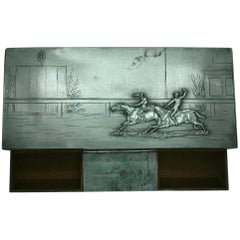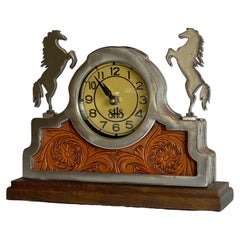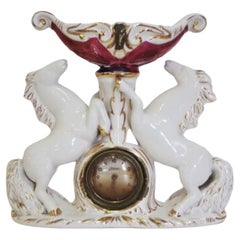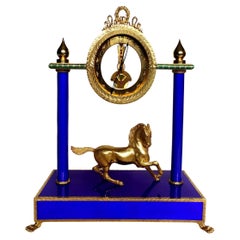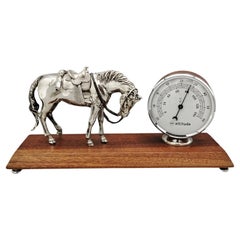Items Similar to Silvered Table Clock With Two Horse heads. German 1910´s
Want more images or videos?
Request additional images or videos from the seller
1 of 10
Silvered Table Clock With Two Horse heads. German 1910´s
$1,290
£999.85
€1,132.07
CA$1,846.53
A$2,013.47
CHF 1,046.50
MX$24,103.88
NOK 13,273.79
SEK 12,433.39
DKK 8,455.07
About the Item
Silvered Table Clock. The clock has a rounded top and a rectangular base. The clock face is circular with black numbers and hands, and it is set into the upper part of the structure. Below the clock face, there are two sculpted horse heads protruding from the base, adding a decorative element to the piece. The overall design suggests a blend of functionality and artistic craftsmanship, making it an interesting and unique item. Perfect gift for any horses or equestrian fan. Working okey.
We have specialized in the sale of Art Deco and Art Nouveau and Vintage styles since 1995. If you have any questions we are at your disposal. Pushing the button that reads 'View All From Seller'. And you can see more objects to the style for sale. Why are there so many antiques in Argentina?
In the 1880 – 1940 there was a grate wave of immigration encouraged by the periods of war that were taking place. 1st World War took place between 1914 and 1918 2nd World War took place between 1939 and 1945 The immigrants options were New York or Buenos Aires. Tickets were cheap and in Buenos Aires they were welcomed with open arms, as it was a country where everything was still to be done. Argentina was the country of new opportunities, labour was needed and religious freedom was assured, in many cases the of the family travel first until they were settled and then the rest of the family members join them. In the immigrant museum “Ellis Island Immigrant Building” in New York you can se the promotional posters of the boats that would take them to a new life. Between the years 1895 and 1896, Argentina had the highest DGP (gross domestic product) per capita in the world according to the Maddison Historical Statistics index, this situation arose due to the large amount of food being exported to European countries, which were at war. The Argentinean ships left the port of Buenos Aires with food, but they returned with furniture, clothes and construction elements, (it´s common to see this the old buildings of the historic neighbourhood of San Telmo, the beams with the inscription “Made in England)”, as well as many markets that were built in Buenos Aires, such us the San Telmo Market, whose structure was brought by ship and afterwards assembled in 900 Defensa Street. With the great influence of European immigrants living in the country, the children of the upper classes travelled to study in France, resulting in the inauguration of “La Maison Argentinienne”, on 27th of June 1928, in the international city of Paris, which hosted many Argentinians that were studying in Frace. It´s the fourth house to be built after France, Canada and Belgium, being the first Spanish-speaking one. Still in place today (17 Bd Jourdan, 75014, Paris, France). Many of the children of these wealthy families who attended international art exhibitions, museums and art courses abroad, took a keen interest in the European style. This is why Buenos Aires was at the time referred as “The Paris of South America”. Between the years 1890 and 1920 more than a hundred Palaces were built on Alvear Avenue the most exclusive avenue in Buenos Aires. Today some of these palaces have been transformed into museums, hotels and embassies. In the year 1936, the Kavanagh building was inaugurated, it was the tallest reinforced concrete building in South America. During 1994 the American Society of Civil Engineers distinguished it as an “international engineering milestone”, and it´s now considered a World Heritage of Modern Architecture. At the time was common to hire foreign architects such as Le Corbusier, who visited Buenos Aires/Argentina in 1929 and in 1948 he drew up the blueprints for a house built in La Plata City (which was declared a World Heritage Site). In 1947, the Hungarian architect Marcelo Breuer designed “Parador Ariston” in the seaside city of Mar del Plata. After an Argentinean student at Harvard University convinced him to come to Argentina. He worked on an urban development project in the Casa Amarilla, area of La Boca. The Ukrainian architect, Vladimiro Acosta, arrives in Argentina in 1928 and worked as an architect until que moved to Brazil. Antonio Bonet, a Spanish architect who worked with Le Corbusier in Paris, arrives in Argentina in 1937, where he carried out several architectural works and in 1938 designs the well-known BFK chair. Andres Kálnay, of Hungarian origin, made around 120 architectural masterpieces, among which the former Munich brewery stands out, he even made the furniture’s design. The German architect, Walter Gropius, director of the Bauhaus, lived in Argentina, where he wrote articles for “Sur” magazine and founded in Buenos Aires, an architectural firm with Franz Möller, who was also an architect, where he built two houses. At the same time several famous designers decided to immigrate to Argentina, among them we can find the well-known French designer, Jean-Michel Frank, who arrived in the country in 1940 and also worked for the Rockefeller family. Special pieces were made, which were sold exclusively in the country, such as the well-known German company “WMF”, who sold their products by catalogue, which were chosen by the ladies of high society in the list of wedding gifts, as well as the pieces designed by Christofle. The Swiss sculptor Alberto Giacometti, made special pieces for Argentinean mansions. In 1904 the first Jansen branch outside Paris was established in Buenos Aires, as the Argentinean clientele demanded a large amount of furniture, from the end of the 19th century to the mid-20th century. In 1970, the brand Rigolleau Argentina made pieces authorised by Lalique. The brands Maple and Thompson also set up shop in the country. The French plastic artist, Marcel Duchamp moved to Argentina in 1918-1919. Glass signed Gallé, Charder, Leverre, Schneider, Muller and other French firms. They were bought in flower shops and were given to ladies with beautiful floral arrangements. Some furniture manufacturers travelled to international fairs and bough the patterns to produce the furniture in Argentina, such as the furniture firm Englander and Bonta, who bought the patterns in Italy. It is worth mentioning that in Argentina we have the largest community of Italians outside of Italy, as it is estimated that 70 percent of the inhabitants have at least one Italian descendant, followed by Spanish immigrants. The most Important furniture stores in Argentina: Comte is founded in 1934 (under the direct management of Jean Michel Frank in 1940). Nordiska (Swedish company established in 1934). Churba in 1960, a company that brought foreign designers to present their furniture in the country: Denmark: (Arne Jacobsen, Finn Juhl, Bender Madsen, Ejner Larsen, Poul Kjaerholm, Hans Wegner) Sweden: (Hans Agne Jakobsson, Gustavsberg) United States: (Herman Miller) Finland: (Lisa Johansson, Folke Arstrom, Tapio Wirkkala, Alvar Aalto, Timo Sarpaneva) Swedish Factory: (Orrefors) Italy: (Littala, Vico Magistretti, Emma Gismondi, Gae Aulenti, Angelo Mangiarotti, Elio Martinelli, Gianna Celada, Angelo Mangiarotti, Mario Bellini, Carlo Scarpa) Finland: (Olivia Toikka) Plata Lappas (Lappas Silver): a goldsmith shop founded in 1887 in Argentina by Alcibiades Lappas of Greek origin. In 2019, in Argentina took place “the Art Deco world congress” . Argentina currently has more than 100 Art Deco buildings and another 90 Art Nouveau buildings throughout the city of Buenos Aires. Argentina is a country that has not been involved in many wars, which is why it has been a refuge for works of art and antiques from different periods of time, unlike European countries. That is way many collectors, museums and antique dealers from all over the world visit it, you should not miss the opportunity to visit this great country.
- Dimensions:Height: 7.49 in (19 cm)Width: 5.71 in (14.5 cm)Depth: 3.94 in (10 cm)
- Style:Arts and Crafts (Of the Period)
- Materials and Techniques:Metal,Silvered
- Place of Origin:
- Period:
- Date of Manufacture:1910´s
- Condition:Repaired. Wear consistent with age and use.
- Seller Location:Buenos Aires, AR
- Reference Number:1stDibs: LU2027343104742
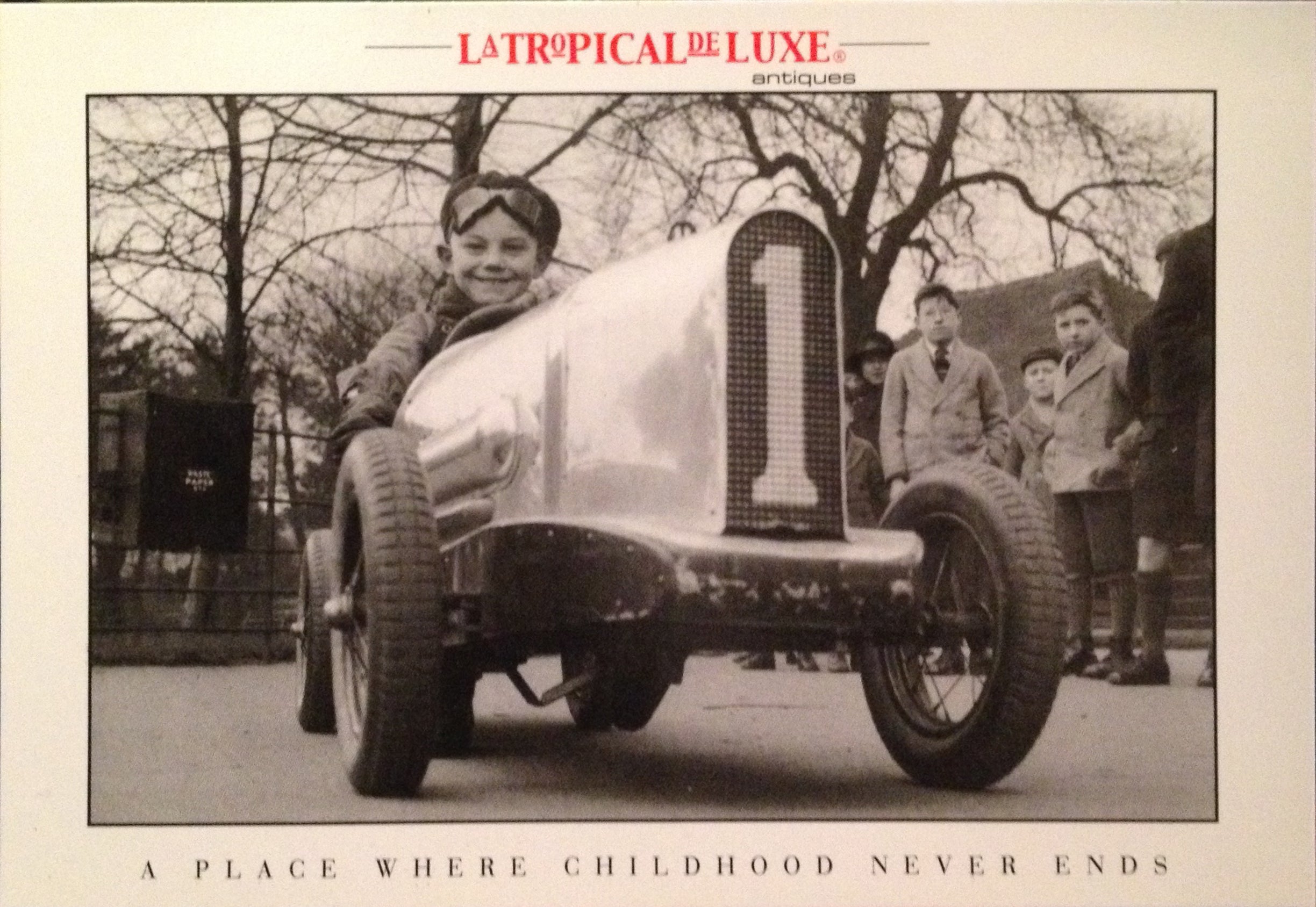
About the Seller
4.9
Vetted Professional Seller
Every seller passes strict standards for authenticity and reliability
Established in 2002
1stDibs seller since 2016
330 sales on 1stDibs
Typical response time: <1 hour
- ShippingRetrieving quote...Shipping from: Buenos Aires, Argentina
- Return Policy
More From This Seller
View AllEquestrian Silvered Bronze Table Push Bell, 1900's
Located in Buenos Aires, Olivos
Equestrian silvered bronze table push bell.
Man riding a horse, or as soon in several british drawings, it can be a fox hunting scene. Classy way to signal y...
Category
Early 20th Century British Art Nouveau Animal Sculptures
Materials
Bronze
Art Deco Laurent Horse Bookends Bronze Sculpture, c 1930, France
By Georges H. Laurent
Located in Buenos Aires, Olivos
Art Deco Georges H. Laurent horse bookends bronze sculpture. c 1925 France. A stunning pair of art deco stylized bookends. Silvered plated bronze Both signed. Mounted over black mar...
Category
Mid-20th Century French Art Deco Animal Sculptures
Materials
Marble, Bronze
Luxury Vintage Stirrup Table Clock Maquet Paris, Nice 8 Jours, France, 1940s
By Hermès, Maquet
Located in Buenos Aires, Olivos
Luxury vintage stirrup desk / table clock Maquet Paris - Nice 8 Jours, France, 1940s
Clock with Equestrian / Polo / Racing horse Motifs in the style of Hermes (exactly the same model but with hermes marks...
Category
Mid-20th Century French Art Deco Table Clocks and Desk Clocks
Materials
Metal
$3,040 Sale Price
20% Off
Free Shipping
Desk Equestrian Horse Racing Cigar Smoking Box, circa 1900s
Located in Buenos Aires, Olivos
Equestrian cigar box with space for matches. Perfect desk piece.
Engraved with racing horses.
We have specialized in the sale of Art Deco and Art Nouveau and Vintage styles since 19...
Category
Early 20th Century American Art Nouveau Tobacco Accessories
Materials
Brass
Art Deco / Mid-Century Hagenauer Two Racing Horses Sculpture. Austria
By Werkstätte Hagenauer Wien
Located in Buenos Aires, Olivos
Art Deco / Mid-Century Hagenauer Two Racing Horses Sculpture. Austria.
Stunning sculpture.
This is a wood and brass double horses sculpture circa 1930’s by Hagenauer . It is signed ...
Category
Mid-20th Century Austrian Mid-Century Modern Animal Sculptures
Materials
Bronze
$4,125 Sale Price
25% Off
Art Deco Table Clock by Jaeger-LeCoultre Ghiso, Rare, 1930s
By Jaeger-LeCoultre, Ghiso
Located in Buenos Aires, Olivos
Art Deco table / desk / mantel clock. We've had this Art Deco beauty fully serviced by an horologist and so comes to you in full working order.
History
Jaeger-LeCoultre (French pro...
Category
Mid-20th Century Swiss Art Deco Table Clocks and Desk Clocks
Materials
Metal
$1,999 Sale Price
20% Off
You May Also Like
Silver Stallion Wood, Tooled Leather, Polished Steel Desk Clock
By Steven Handelman
Located in Santa Barbara, CA
The Silver Stallion is one of several high end Western themed items produced by Steven Handelman Studios in 2019. The consept was to make something th...
Category
20th Century American American Classical Mantel Clocks
Materials
Iron
Charming 1950s Horse-Themed Mantel Clock - Vintage Elegance
Located in Manzano, IT
Charming 1950s Horse-Themed Mantel Clock - Vintage Elegance
Infuse your home with a touch of vintage charm with this delightful 1950s mantel clock featuring a horse motif. Crafted w...
Category
Vintage 1950s Italian Table Clocks and Desk Clocks
Materials
Ceramic, Glass
Table Clock Sterling Silver Large with Horse Sculpture Salimbeni
By Giorgio Salimbeni, Salimbeni
Located in Firenze, FI
Large table clock in 925/1000 sterling silver gold plated with translucent fired enamels on guillochè, formed by a rectangular base of cm. 12 x 24 x ...
Category
Vintage 1980s Italian Islamic Table Clocks and Desk Clocks
Materials
Amethyst, Sterling Silver, Enamel
$31,711 Sale Price
20% Off
Free Shipping
XX Century Italian Sterling Silver Horse and thermometer in wooden base
By Creazioni Sacchetti
Located in VALENZA, IT
Composition in silver and wood depicting a horse with saddle and bridle in sterling silver and room thermometer on a wooden base.
The horse was made with the casting technique and th...
Category
Late 20th Century Italian Other Animal Sculptures
Materials
Sterling Silver
20th Century Solid Silver Horse Racing Clock, Edinburgh, circa 1983
Located in Royal Tunbridge Wells, Kent
Unusual 20th century solid silver clock on green marble base, the clock set between a horse-shoe and mounted with a jockey, stirrups and riding crops. The clock is in fully working o...
Category
20th Century British Table Clocks and Desk Clocks
Materials
Marble, Silver
Early 20th Century Art Nouveau Silver Carriage Clock By William Comyns London
By William Comyns
Located in Dublin, IE
A very fine Art Nouveau silver carriage clock made in 1902 by William Comyns. The doomed shaped case has a 4.5 cm enamelled dial with Roman numbers and black steel hands, 8-day sprin...
Category
Antique Early 1900s English Art Nouveau Carriage Clocks and Travel Clocks
Materials
Silver
More Ways To Browse
Plata Lappas
Antique Silver Table
Two Headed
1970 S Early American Furniture
Antique Horse Heads
Arts And Crafts Furniture Canadian
Antique German Desk
German Antiques
German Arts And Crafts
Antique Silver Horse
Antiques Arts And Crafts
German Horse
Antique Metal Horse
Early 20th Century Desk Maple
Horse Head Table
Antique Round Clock
Antique German Horse
Furniture With Horse Head
